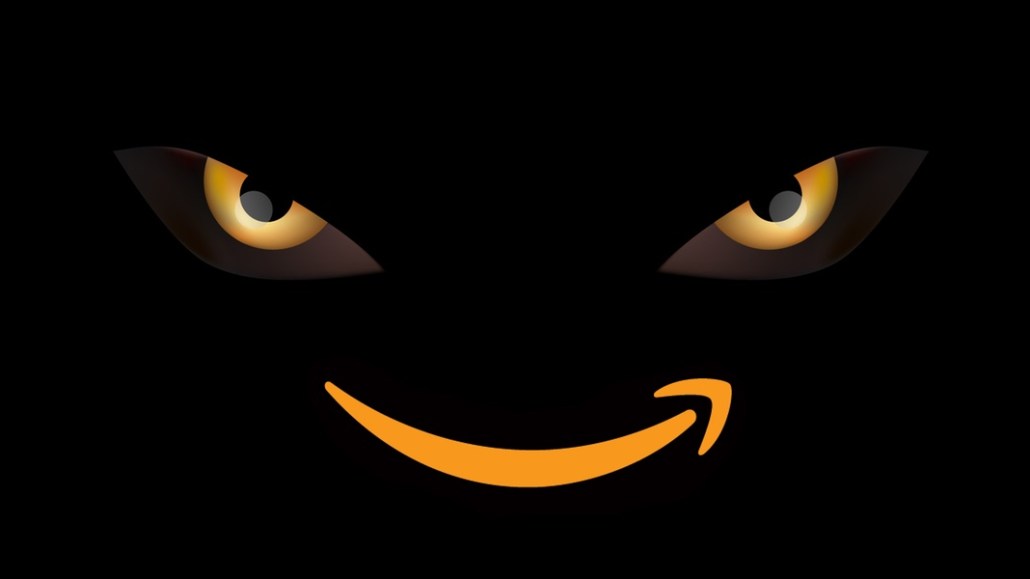Save 50% on a 3-month Digiday+ membership. Ends Dec 12.
Nike’s frenemy approach to Amazon is a harbinger of things to come

Amazon presents a conundrum for retailers. It can crush retailers — but it can also bolster them.
On Wednesday, sources told Bloomberg News that Amazon will begin selling Nike through its brand registry program, following a Goldman Sachs analyst note that said Nike is “close” to selling directly on Amazon.com. That’s a massive change: Nike products, of course, are already available on Amazon through other resellers, which are unlicensed. Citing “channel checks,” the Goldman analyst wrote that this would be an important opportunity for three reasons: Economic exposure to Amazon’s massive retail scale; control over how its brand is presented; and access to the millennial cohort.
The second part is important because Amazon provides to direct sellers access to what is known as its enhanced brand registry, which lets brands control their messaging, handle customer feedback and get valuable information like what colors people are picking, what else they are searching for and so on. It can also help guard against counterfeits.
“This is the foundation of the house of why Nike would sell to Amazon,” said Marketplace Ignition CEO Eric Heller. “By not selling on it, you can lose control.” And Nike was losing out to other sports competitors on the platform because it didn’t have a dedicated brand store.
There’s also the money. Sales to Amazon represent between 2 and 4 percent of sales for wholesale brands, according to the Goldman Sachs note. That means Nike could earn incremental revenue of up to $500 million in the U.S.
That kind of play-nice approach is in some ways also at odds with Nike’s outward competition with Amazon.
Last week, Nike introduced a new program called Consumer Direct Offense. The program refocused Nike from global to local: creating “key cities” in the world in which it sees most of its growth and getting more digital there.
Those cities include New York, London, Shanghai, Beijing, Los Angeles, Tokyo, Paris, Berlin, Mexico City, Barcelona, Seoul and Milan, and they’re expected to drive 80 percent of the company’s growth through 2020. The brand is also on a mission as part of Consumer Direct Offense to double its speed of both product innovation and direct connections with its customers. To do this, Nike is reducing the number of its styles by 25 percent and cutting product creation cycles by extending “Express Lane,” its speedy product-fulfillment arm, into China this summer. Susquehanna analyst Sam Poser said the reset means getting more personalized products to customers quickly will be a top priority.
The unmentioned — yet glaring — part of the strategy is that Amazon has a growing interest in on-demand manufacturing. The company has a patent pending that will let it aggregate orders across the world, then coordinate the assembly and production process on a large scale in apparel. Amazon is also, of course, active in activewear, and according to reports, plans to develop its own line. And with Prime, its high delivery standards and supply-chain scale, Amazon knows how to get things to people quickly.
Both strategies — one working with Amazon and the other competing with it — are emblematic of the retail giant’s massive reach and scale.
“You have to be on Amazon,” said Herb Sawyer, iCrossing’s vp of strategy. “So you’ve got to figure out a way to parallel-path like Amazon. You have to have a platform where the store is in your pocket, but also speak to people who are thinking beyond the immediate buy and get them beyond a commodity purchase.”
Outside of retail, Amazon is also growing tentacles in both media and advertising: Amazon has product display ads, search products and a burgeoning content business.
“Every brand is reconsidering their plan to not engage with Amazon,” said Heller. “And far more are realizing that Amazon is the Consumer Reports of this decade. Even if I don’t use [Amazon] to drive revenue, I’ll use it to drive reputation.”
More in Marketing

‘We just did the math’: The new baseline for ad tech transparency
Ad execs said the industry is shifting toward a renewed transparency push driven as much by day-to-day operational pressure as by principle.

In Graphic Detail: Here’s what the creator economy is expected to look like in 2026
Digiday has charted its expected revenue, key platforms for creator content as well as what types of creators brands want to work with.

Ulta, Best Buy and Adidas dominate AI holiday shopping mentions
The brands that are seeing the biggest boost from this shift in consumer behavior are some of the biggest retailers.







